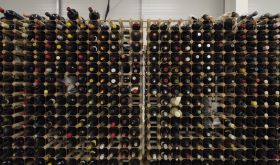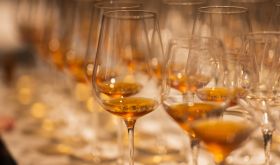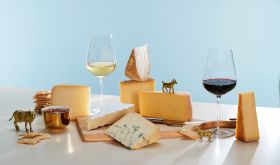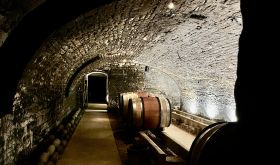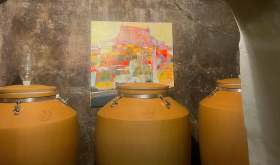Note: In order to deliver this article to you as early as possible, it has been translated with the use of AI. It has been added to a queue for a human translator to fully review and edit. Please pardon any minor translation imperfections while it is being reviewed.
南罗纳河谷葡萄品种歌海娜 (Grenache) 目前在澳大利亚风头正劲,而仅仅几年前它还被视为低等的劳役马。然而,很少有例子能像典型的教皇新堡 (Châteauneuf-du-Pape)——法国最著名的歌海娜基础红酒——那样强劲。大多数澳大利亚歌海娜生产商似乎都在以西班牙新浪潮中相当勃艮第风格的该品种版本为模板,在西班牙被称为加尔纳恰 (Garnacha)。
澳大利亚歌海娜现在更可能是淡色、芳香、果味浓郁且易于接受的,而不是厚重、坚韧和大胆的,尽管也有例外。不幸的是,歌海娜需要在藤上相当长的时间来发展风味和充分成熟的单宁,这意味着低酒精度的歌海娜确实是稀有品种。在伦敦最近对45款澳大利亚歌海娜的品鉴中,只有阿尔基纳 (Alkina)、罗伯特·奥特利 (Robert Oatley)、卡勒斯克 (Kalleske) 和奥乔塔酒桶 (Ochota Barrels) 成功推出了酒精度低于14%的红酒——而这正值英国进口商迫切希望最小化指定酒精度的时候,因为现在税收是如此精确地基于酒精度计算的。
就像加利福尼亚的优质仙粉黛 (Zinfandel) 一样,古老的灌木藤是这些葡萄酒魅力的关键,巴罗萨谷 (Barossa Valley) 和麦克拉伦谷 (McLaren Vale)——分别位于南澳大利亚阿德莱德的东北和南部(如这张世界葡萄酒地图集概览图所示)——是热点地区。麦克拉伦谷歌海娜是第一个变得时尚的,尽管设拉子 (Shiraz) 在那里种植得更为广泛。正如简·洛佩斯 (Jane Lopes) 和乔纳森·罗斯 (Jonathan Ross) 在他们2023年的著作如何饮用澳大利亚酒中报告的,麦克拉伦谷葡萄园中种植歌海娜的不到7%——主要是因为在1980年代的拔藤计划中,40%的歌海娜消失了,当时歌海娜葡萄几乎只有阿德莱德的意大利家庭购买用于自制葡萄酒。
巴罗萨谷葡萄园中种植设拉子的比例甚至更高,约70%,尽管古老的设拉子藤像古老的歌海娜藤一样在同一个拔藤计划中遭受损失,当时法国的赤霞珠 (Cabernet Sauvignon) 看起来——暂时地——如此更有魅力。虽然巴罗萨更容易与设拉子联系在一起,但巴罗萨谷歌海娜最近也在掀起波澜。巴罗萨谷是可能世界上最古老的歌海娜葡萄园的所在地,奇里洛 (Cirillo) 的葡萄园种植于19世纪中期。同样在巴罗萨谷,南澳大利亚家族集团雅伦堡 (Yalumba) 用1889年在藤谷 (Vine Vale) 地区种植的一块灌木藤制作他们的三百周年歌海娜 (Tri-Centenary Grenache)。
在麦克拉伦谷,由于斯马特 (Smart) 家族的坚持,一些百年歌海娜藤以某种方式设法存活下来。他们在克拉伦登 (Clarendon) 地区1922年种植的葡萄园现在特别著名,来自该园的果实在伦敦品鉴中出现在威伦加100 (Willunga 100) 和云端部 (Ministry of Clouds) 的葡萄酒中。所有这些古老藤蔓仍然留在地里是一个奇迹。
两个地区澳大利亚歌海娜变轻的一个重要因素是从使用波尔多和勃艮第使用的那种小型新橡木桶(可以浓缩风味)转向使用更古老、更大的酒桶,或者越来越多地在混凝土罐、陶土容器甚至陶瓷蛋形容器中陈酿葡萄酒。
虽然"温和黑皮诺 (Pinot Noir)"风格的歌海娜非常迷人、多样且讨人喜欢,但我怀疑这些葡萄酒中的许多将有相对较短的生命。我在这些葡萄酒中发现了更有野心的例子——仍然诱人但具有更多结构和复杂性——比如教堂山 (Chapel Hill) 的MV 2020、来自沙质布莱维特泉 (Blewitt Springs) 地区的MMAD 2022、所有S C 潘内尔 (S C Pannell) 葡萄酒(尽管潘内尔夫妇最近亲自收购的小分支 (Little Branch) 葡萄园中的藤蔓仅有30年历史)、威伦加100的例子、蓟绒 (Thistledown) 的山上傻瓜 (Fool on the Hill) 2022来自巴罗萨谷地面上方的伊甸谷 (Eden Valley),以及来自扬加拉 (Yangarra) 的所有葡萄酒,扬加拉是最早采用非传统容器陈酿的酒庄之一。
扬加拉由美国人于2001年创立,是国际集团杰克逊家族酒庄 (Jackson Family Wines)的成员,远在歌海娜完全受到尊重之前。(洛佩斯和罗斯报告说,直到2020年麦克拉伦谷歌海娜的葡萄价格才超过设拉子。)它充分利用了1946年用来自原始斯马特葡萄园插条种植的一块歌海娜藤。关于扬加拉和斯马特家族的完整故事,请见这里。
其他进入"谷地"的新来者要晚得多。MMAD由北部阿德莱德山 (Adelaide Hills) 肖+史密斯 (Shaw + Smith) 背后的团队组成,于2021年购买了他们的古老藤蔓,其中一些早在1939年就种植了。罗伯特·奥特利酒庄 (Robert Oatley Wines) 在新南威尔士州和西澳大利亚州都有相当规模的业务,于2017年开始制作未经橡木桶陈酿的麦克拉伦谷歌海娜,并在2023年增加了更严肃的菲尼斯特雷歌海娜 (Finistere Grenache),基于从布莱维特泉一个80年历史葡萄园购买的果实。
马克·布尔曼 (Mark Bulman) 在巴罗萨的火鸡平地 (Turkey Flat) 时赢得了著名的吉米·沃森奖杯 (Jimmy Watson Trophy),刚刚推出了布尔曼酒庄 (Bulman Wines) 的单一葡萄园古藤歌海娜,一款来自伊甸谷,一款来自麦克拉伦谷,在他描述为砂岩陶罐中陈酿,两款葡萄酒都比大多数更年轻,显然是为餐桌而非酒吧制作的。他这样描述本文顶部的图片,取自布尔曼酒庄网站:"这张照片是现已废弃的斯托克韦尔(巴罗萨的一个小镇)谷物筒仓(过去用于储存收获的谷物),从我为制作桃红酒采购歌海娜的葡萄园拍摄的。"
在巴罗萨谷,阿尔基纳 (Alkina)是一个有趣的新来者。阿根廷石油和天然气亿万富翁亚历杭德罗·布尔格罗尼 (Alejandro Bulgheroni)在乌拉圭、阿根廷、加利福尼亚和托斯卡纳总共拥有14家酒庄,阿尔贝托·安东尼尼 (Alberto Antonini) 担任他的巡回酿酒顾问。他还聘请了四处游历的智利葡萄酒专业土壤科学家佩德罗·帕拉 (Pedro Parra) 将他在巴罗萨购买的土地划分为他们称为多边形的小型同质地块。他们九年前种植了更多歌海娜,但非常吸引我的庄园歌海娜 (Estate Grenache) 2024中80%来自1950年代种植的藤蔓。他们追求严格的再生农业技术,当地酿酒师阿米莉亚·诺兰 (Amelia Nolan) 只使用混凝土陈酿她的歌海娜,甚至阿尔基纳的多边形3歌海娜 (Polygon 3 Grenache) 2023,在澳大利亚售价近300澳元一瓶。
澳大利亚歌海娜的价格随着其声誉的提升而全面上涨。在他们的网站上,扬加拉对他们顶级高沙歌海娜 (High Sands Grenache) 装瓶的当前2021年份收费300澳元,该酒来自那个1946年的地块。
在伦敦品鉴中,除了我在下面推荐的蒂姆·史密斯 (Tim Smith) 葡萄酒外,性价比最好的歌海娜可能是雅伦堡塞缪尔收藏系列 (Yalumba's Samuel's Collection) 中的巴罗萨灌木藤歌海娜 (Barossa Bush Vine Grenache) 2022,它由60-105年历史的藤蔓制成。我之后品尝了2021年份,可以完全推荐它,在伦敦终点 (London End) 售价17英镑,在弗雷泽 (Fraziers) 和澳大利亚葡萄酒在线 (Australian Wines Online) 不超过20英镑。2022年份预计在一两个月内替代它。为了最大化新鲜度,10%的葡萄提早采摘,10%的茎保留在发酵桶中。为了最大化风味,这个混酿中许多不同成分的30%与葡萄皮浸渍了近三个月。这似乎是结合南澳大利亚和歌海娜葡萄特性的成功配方。
歌海娜是大多数普罗旺斯桃红酒的主要葡萄,澳大利亚品鉴中的两款粉红葡萄酒确实非常出色。查菲兄弟 (Chaffey Bros) 的勒克斯维尼特桃红 (Lux Venit Rosé) 2023由75年历史的藤蔓制成,而奥乔塔酒桶的冲浪者罗莎 (Surfer Rosa) 2024含有3%的琼瑶浆 (Gewürztraminer),基于1946年种植的藤蔓。建议零售价分别为21英镑和32英镑,对于寻找真正有特色粉红葡萄酒的人来说,这些绝对值得寻找。
这次品鉴,就像澳大利亚歌海娜场景一样,可能被特别注重可持续性的麦克拉伦谷和巴罗萨谷主导(那里许多藤蔓也是有机和/或生物动力种植的),但也有来自西澳大利亚更凉爽的弗兰克兰河 (Frankland River) 和克莱尔谷 (Clare Valley) 的例子。澳大利亚歌海娜正在享受它在阳光下的时刻。
南澳大利亚歌海娜
所有这些都从我这里获得了20分中至少17分。
17.5
蒂姆·史密斯 (Tim Smith),歌海娜 2022 巴罗萨 14.5%
£27.50 利亚与桑德曼 (Lea & Sandeman)
威伦加100,斯马特葡萄园克拉伦登歌海娜 2023 麦克拉伦谷 14%
£28.95 布伦瑞克精品酒类 (Brunswick Fine Wines & Spirits)
阿尔基纳,庄园歌海娜 2024 巴罗萨谷 13.5%
£39 雷伯恩精品酒类 (Raeburn Fine Wines) 8月起
SC 潘内尔,小分支布莱维特泉歌海娜 2022 麦克拉伦谷 14.5%
£49.95 NY 葡萄酒 (NY Wines)
17
S C 潘内尔,巴索加尔纳恰 2021 麦克拉伦谷 14%
£22.75 亚历山大·哈德利 (Alexander Hadleigh)
教堂山,MV 灌木藤歌海娜 2020 麦克拉伦谷 14.5%
£23 澳大利亚葡萄酒在线
奥乔塔酒桶,逃亡者歌海娜 (The Fugazi Grenache) 2024 麦克拉伦谷 13.1%
£35.10 干渴藤蔓 (Parched Vine)
迪伦·格里格 (Dylan Grigg),维尼亚维拉 (Vinya Vella),古老灌木藤歌海娜 2022 巴罗萨谷 14%
£41.36 克拉克·福伊斯特 (Clark Foyster)
MMAD 葡萄园,布莱维特泉歌海娜 2022 麦克拉伦谷 14%
£43.95 NY 葡萄酒
蓟绒,山上傻瓜歌海娜 2022 伊甸谷 14.5%
£49 酒贩子 (Drinkmonger)
托布雷克 (Torbreck),山坡葡萄园歌海娜 2021 巴罗萨谷 15%
£58 伦敦终点
扬加拉,希金博瑟姆克拉伦登歌海娜 (Hickinbotham Clarendon Grenache) 2020 麦克拉伦谷 14.5%
£62 费勒姆酒窖 (Fareham Wine Cellar)
品鉴笔记、评分和建议饮用日期,请见新浪潮澳洲歌海娜——葡萄酒。国际经销商信息,请见Wine-Searcher.com。
回到基础
| 关于歌海娜的一切 |
|
阿拉贡 (Aragón) 可能是西班牙人称为加尔纳恰 (Garnacha) 的葡萄品种的发源地,尽管称其为卡农瑙 (Canonnau) 的撒丁岛人声称它起源于他们的岛屿。存在浅色突变品种白歌海娜 (Grenache Blanc) 和灰歌海娜 (Grenache Gris),但迄今为止最常见的是深色皮的加尔纳恰廷塔/黑歌海娜 (Garnacha Tinta/Grenache Noir),它在各种别名下在世界各地种植——但严格限于温暖地区,因为它对凉爽地区来说成熟得太晚。
它的果皮——葡萄着色物质的所在——通常不那么厚,所以生产的葡萄酒通常不像过去如此受推崇的桶陈赤霞珠和丹魄 (Tempranillo) 那样颜色深。但现在口味已经转向更轻、更新鲜的葡萄酒,加尔纳恰/歌海娜已经迎来了自己的时代——特别是在西班牙,那里该国大部分地区都有古老灌木藤(不在铁丝上训练)的地块。
在法国,它最常见于南罗纳河谷,作为丰富、香辣红酒的主要成分,如教皇新堡、吉贡达斯 (Gigondas) 和罗纳河谷丘 (Côtes du Rhône),其中西拉 (Syrah) 等其他葡萄品种加深了颜色。
使该品种越来越受欢迎的另一个因素是它可以在干燥,更不用说干旱条件下茁壮成长。澳大利亚和加利福尼亚部分地区特别倾向于"地中海"品种如歌海娜,这一趋势非常显著。 |



